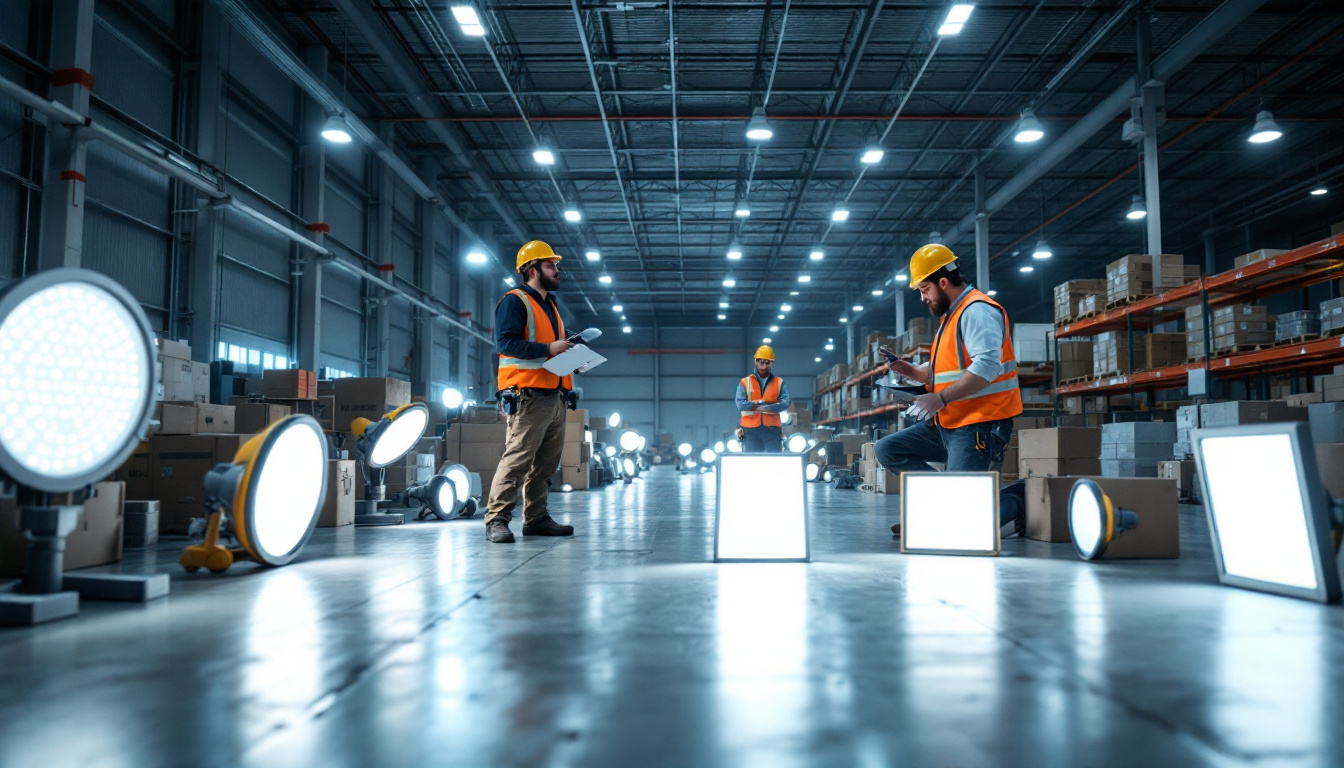
In the ever-evolving world of warehouse lighting, LED lamps have emerged as a game-changer, offering energy efficiency, longevity, and superior illumination. For lighting contractors, understanding the nuances of LED technology and its application in warehouse settings is crucial. This article provides essential tips and insights to help contractors make informed decisions when selecting and installing LED lamps in warehouses.
Before delving into the practical aspects of LED lamps for warehouses, it is vital to grasp the fundamentals of LED technology. Light Emitting Diodes (LEDs) function differently from traditional lighting solutions, which impacts their performance and suitability for various environments.
LEDs produce light when an electric current passes through a semiconductor material, causing it to emit photons. This process is known as electroluminescence. Unlike incandescent bulbs that generate light through heat, LEDs are much more efficient, converting a higher percentage of energy into light rather than heat. This efficiency translates into lower energy costs and reduced cooling requirements in warehouse settings.
The advantages of using LED lamps in warehouses are manifold. Firstly, they offer significant energy savings, often reducing electricity consumption by up to 75% compared to traditional lighting options. Secondly, LEDs have a longer lifespan, lasting up to 50,000 hours or more, which minimizes the need for frequent replacements and maintenance.
Additionally, LEDs provide better quality light, with options for various color temperatures that can enhance visibility and safety in work environments. Their durability also means they can withstand harsh conditions often found in warehouses, such as dust and temperature fluctuations. The ability to produce bright, uniform lighting reduces shadows and enhances the overall safety of the workspace, making it easier for employees to navigate and perform their tasks efficiently.
Moreover, the versatility of LED technology allows for innovative lighting solutions, such as smart lighting systems that can be controlled remotely. These systems can adjust brightness levels based on the time of day or occupancy, further optimizing energy use and ensuring that areas are well-lit only when necessary. This adaptability not only contributes to energy efficiency but also aligns with sustainability goals, making LED lighting a forward-thinking choice for modern warehouses looking to reduce their carbon footprint.
Selecting the appropriate LED lamps for a warehouse involves several considerations. Factors such as brightness, color temperature, and beam angle can significantly impact the effectiveness of the lighting solution.
When evaluating LED lamps, brightness is measured in lumens rather than watts. This shift in measurement is crucial because it allows for a more accurate assessment of how much light a fixture will produce. For warehouses, a higher lumen output is generally necessary to ensure adequate visibility for tasks such as picking, packing, and inventory management.
As a rule of thumb, warehouses typically require between 300 to 500 lumens per square meter, depending on the specific activities taking place. For areas with higher activity levels, such as loading docks or assembly lines, aiming for the upper end of this range is advisable. Additionally, it is important to consider the layout of the warehouse; high ceilings may necessitate fixtures with a higher lumen output to ensure that light reaches the floor effectively. The strategic placement of lighting can also minimize shadows and enhance safety, particularly in busy environments where employees are maneuvering equipment and products.
Color temperature, measured in Kelvin (K), affects how light appears in a space. For warehouses, a cooler color temperature, typically between 4000K and 5000K, is recommended. This range mimics daylight and enhances visibility, reducing eye strain for workers. However, it is essential to consider the specific tasks being performed; warmer temperatures may be more suitable for areas where employees spend extended periods. For instance, break rooms or offices within the warehouse might benefit from softer, warmer lighting to create a more inviting atmosphere.
Furthermore, the choice of color temperature can influence productivity levels. Research has shown that cooler light can enhance alertness and concentration, making it particularly beneficial in areas where precision is required. Conversely, warmer light can foster a sense of comfort and relaxation, which is vital in spaces designed for rest or informal meetings. Therefore, a thoughtful approach to color temperature not only enhances the functionality of the warehouse but also contributes to the overall well-being of the workforce.
Proper installation is critical to maximizing the benefits of LED lighting in warehouses. Following best practices can ensure optimal performance and longevity of the lighting system.
Before installation, a comprehensive lighting layout should be developed. This involves assessing the warehouse’s dimensions, the height of the ceilings, and the specific tasks performed in different areas. A well-planned layout ensures even distribution of light, minimizing shadows and dark spots.
Utilizing lighting design software can aid in visualizing the layout and determining the number of fixtures required. This step is crucial in preventing over- or under-lighting, both of which can lead to inefficiencies and safety hazards.
LED lamps can be mounted in various ways, including surface-mounted, suspended, or recessed. The choice of mounting method should align with the warehouse’s operational needs and ceiling height. For instance, high ceilings may benefit from suspended fixtures that provide optimal light distribution without being obstructive.
Additionally, ensuring that fixtures are securely mounted and positioned correctly will enhance their performance and longevity. Regular inspections post-installation can help identify any issues early on.
Energy efficiency is a primary consideration for warehouses looking to reduce operational costs. LED lamps not only consume less energy but also contribute to sustainability goals.
Incorporating smart technology into LED lighting systems can further enhance energy efficiency. Smart controls, such as motion sensors and timers, can automatically adjust lighting based on occupancy and time of day. This feature is particularly beneficial in warehouses where areas may not be in constant use.
For example, motion sensors can dim or turn off lights in aisles that are not currently being accessed, leading to substantial energy savings over time. Additionally, integrating these systems with building management software can provide valuable data on energy consumption and help identify further optimization opportunities.
As warehouses transition to LED lighting, it is essential to consider the end-of-life disposal of lighting fixtures. Unlike traditional bulbs, which can contain hazardous materials, LEDs are generally more environmentally friendly. However, they still require proper recycling to minimize waste and environmental impact.
Contractors should educate clients on the importance of recycling LED lamps and provide resources for proper disposal. Many manufacturers offer take-back programs or partnerships with recycling facilities to ensure that old fixtures are disposed of responsibly.
While LED lamps are known for their durability, regular maintenance is still necessary to ensure optimal performance and longevity. Understanding maintenance best practices can help contractors extend the life of the lighting system.
Conducting regular inspections of the lighting system is crucial. This includes checking for any flickering lights, dimming, or color shifts, which may indicate a need for replacement. Additionally, inspecting fixtures for dust accumulation or physical damage can prevent performance issues.
Establishing a maintenance schedule can help ensure that inspections are conducted consistently, allowing for timely interventions when issues arise. This proactive approach can save costs in the long run by preventing more extensive repairs or replacements.
Keeping LED fixtures clean is essential for maintaining their brightness and efficiency. Dust and grime can accumulate on fixtures, reducing light output and affecting visibility. Regular cleaning schedules should be established, particularly in warehouses where dust and debris are prevalent.
Using appropriate cleaning materials and methods is vital to avoid damaging the fixtures. Soft cloths and non-abrasive cleaners are recommended to maintain the integrity of the lamps while ensuring a clean and efficient lighting system.
When installing LED lamps in warehouses, compliance with safety standards and regulations is non-negotiable. Understanding these requirements is essential for contractors to ensure that installations meet legal and safety guidelines.
Each region may have specific codes and regulations regarding warehouse lighting. Familiarizing oneself with local building codes, electrical codes, and safety standards is crucial for compliance. This knowledge not only protects the contractor from potential legal issues but also ensures the safety of warehouse employees.
Consulting with local authorities or industry associations can provide valuable insights into current regulations and best practices. Staying updated on any changes in legislation is also essential to maintain compliance.
Emergency lighting is a critical aspect of warehouse safety. Contractors must ensure that adequate emergency lighting is integrated into the design, providing illumination in case of power outages or emergencies. This includes exit signs, pathway lighting, and backup systems that activate during power failures.
Regular testing and maintenance of emergency lighting systems are necessary to ensure functionality when needed. Understanding the specific requirements for emergency lighting in warehouses can help contractors design compliant and safe lighting systems.
Incorporating LED lamps into warehouse lighting systems presents numerous advantages, from energy efficiency to enhanced visibility. For lighting contractors, understanding the intricacies of LED technology, installation best practices, and maintenance strategies is essential for delivering optimal solutions to clients.
By staying informed about the latest developments in LED technology and adhering to safety standards, contractors can ensure that their installations are not only effective but also sustainable and compliant. The transition to LED lighting is not just a trend; it is a crucial step toward creating safer, more efficient, and environmentally friendly warehouse environments.
As the demand for energy-efficient solutions continues to grow, lighting contractors who embrace LED technology will be well-positioned to meet the needs of their clients and contribute to a more sustainable future.
Ready to elevate your warehouse lighting projects with the efficiency and brilliance of LED technology? Look no further than LumenWholesale for all your lighting needs. Our spec-grade lighting products are designed to meet the highest industry standards, ensuring you deliver top-notch solutions to your clients. With unbeatable wholesale prices and the convenience of free shipping on bulk orders, you can trust LumenWholesale to provide premium lighting without the premium price tag. Make the smart choice for your business and explore our collection for Wholesale Lighting at the Best Value today.

Discover how understanding light bulb base types can give you a competitive edge in securing more lighting contracts.

Discover the fascinating history and science behind fluorescent light bulbs.

Discover essential insights into wrap lighting fixtures with our comprehensive guide tailored for lighting contractors.

Illuminate your expertise with our comprehensive guide on garden landscape lighting.